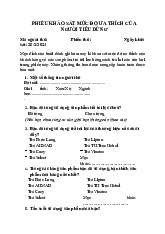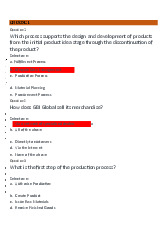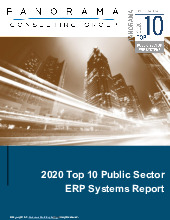



















Preview text:
lOMoAR cPSD| 58794847 Concepts in Enterprise Resource Planning Fourth Edition Chapter One
Business Functions and Business Processes lOMoAR cPSD| 58794847 Objectives
After completing this chapter, you will be able to:
• Name the main functional areas of operation used in business
• Differentiate between a business process and a business function
• Identify the kinds of data each main functional area produces
• Identify the kinds of data each main functional area needs
• Define integrated information systems, and explain why
they are essential in today’s globally competitive business environment lOMoAR cPSD| 58794847 Introduction
• Enterprise Resource Planning (ERP) programs:
Core software used by companies to coordinate
information in every area of business
– Help manage companywide business processes
– Use common database and shared management reporting tools
• Business process: Collection of activities that
takes some input and creates an output that is of value to the customer Functional Areas and Business Processes
• To understand ERP, you must understand how a business works lOMoAR cPSD| 58794847
– Functional areas of operation – Business processes lOMoAR cPSD| 58794847 Functional Areas of Operation • Marketing and Sales (M/S)
• Supply Chain Management (SCM)
• Accounting and Finance (A/F) • Human Resources (HR)
• Business functions: Activities specific to a functional area of operation lOMoAR cPSD| 58794847
Functional Areas of Operation (cont’d.)
Figure 1-1 Examples of functional areas of operation and their business functions lOMoAR cPSD| 58794847
Functional Areas of Operation (cont’d.)
• Functional areas are interdependent
– Each requires data from the others
• Better integration of functional areas leads to
improvements in communication, workflow, and success of company
• Information system (IS): Computers, people,
procedures, and software that store, organize, and deliver information Business Processes
• Collection of activities that takes one or more kinds
of input and creates an output that is of value to customer lOMoAR cPSD| 58794847
– Customer can be traditional external customer or internal customer
• Thinking in terms of business processes helps
managers to look at their organization from the customer’s perspective
Business Processes (cont’d.)
Figure 1-2 Sample business processes related to the sale of a personal smartphone lOMoAR cPSD| 58794847
Business Processes (cont’d.)
• Businesses must always consider customer’s viewpoint in any transaction
• Successful customer interaction
– Customer (either internal or external) is not required
to interact with each business function involved in the process
• Successful business managers view business
operations from the perspective of a satisfied customer
Business Processes (cont’d.)
• Sharing data effectively and efficiently between and
within functional areas leads to more efficient business processes lOMoAR cPSD| 58794847
• Integrated information systems: Systems in
which functional areas share data
Business Processes (cont’d.)
Figure 1-3 A process view of business lOMoAR cPSD| 58794847
Business Processes (cont’d.)
• Businesses take inputs (resources) and transform
these inputs into goods and services for customers
– Inputs: Material, people, equipment
• Managing inputs and business processes
effectively requires accurate and up-to-date information Functional Areas and Business
Processes of a Very Small Business
• Example: A fictitious coffee shop
– Examine business processes of the coffee shop
– See why coordination of functional areas helps
achieve efficient and effective business processes lOMoAR cPSD| 58794847
– Look at how integration of the information system improves the business Marketing and Sales
• Functions of Marketing and Sales – Developing products – Determining pricing
– Promoting products to customers
– Taking customers’ orders
– Helping create a sales forecast
Marketing and Sales (cont’d.)
• Marketing and Sales tasks for the coffee shop
– Formal recordkeeping not required
– Need to keep track of customers lOMoAR cPSD| 58794847
– Product development can be done informally
– Good repeat customers allowed to charge purchases—up to a point
• Records must show how much each customer owes and his or her available credit Supply Chain Management
• Functions within Supply Chain Management
– Making the coffee (manufacturing/production)
– Buying raw materials (purchasing)
• Production planning requires sales forecasts from
Marketing / Sales functional area
– Sales forecasts: Analyses that attempt to predict the future sales of a product lOMoAR cPSD| 58794847
Supply Chain Management (cont’d.)
• Production plans used to develop requirements for raw materials and packaging
– Raw materials: Bottled spring water, fresh lemons,
artificial sweetener, raw sugar
– Packaging: Cups, straws, napkins
• SCM and M/S must choose a recipe (công thức) for each coffee product sold Accounting and Finance
• Functions within Accounting and Finance
– Recording raw data about transactions (including
sales), raw material purchases, payroll, and receipt of cash from customers lOMoAR cPSD| 58794847
• Raw data: Numbers collected from sales,
manufacturing and other operations, without any
manipulation, calculation, or arrangement for presentation
Accounting and Finance (cont’d.)
• Data from Accounting and Finance used by
Marketing and Sales and Supply Chain Management
– Sales records are important component of sales forecast
– Sales forecast is used in making staffing decisions and in production planning
– Records from accounts receivable used to monitor
the overall credit-granting policy of the coffee shop lOMoAR cPSD| 58794847 Human Resources
• Functions of Human Resources
– Recruit, train, evaluate, and compensate employees
• HR uses sales forecasts developed by the
individual departments to plan personnel needs
• Systems integrated using ERP software provide the
data sharing necessary between functional areas
Functional Area Information Systems
• Potential inputs and outputs for each functional area described next
• Note the kinds of data needed by each area and how people use the data lOMoAR cPSD| 58794847
• Information systems maintain relationships
between all functional areas and processes Marketing and Sales
• Needs information from all other functional areas
• Customers communicate orders to M/S in person or
by telephone, e-mail, fax, the Web, etc.
• M/S has a role in determining product prices
– Pricing might be determined based on a product’s
unit cost, plus some percentage markup
– Requires information from Accounting and Finance,
and Supply Chain Management data lOMoAR cPSD| 58794847
Marketing and Sales (cont’d.)
Figure 1-4 The Marketing and Sales functional area exchanges data with
customers and with the Human Resources, Accounting and Finance, and
Supply Chain Management functional areas lOMoAR cPSD| 58794847
Marketing and Sales (cont’d.)
• M/S needs to interact with Human Resources to
exchange information on hiring needs, legal requirements, etc. • Inputs for M/S – Customer data – Order data – Sales trend data – Per-unit cost
– Company travel expense policy
Marketing and Sales (cont’d.) • Outputs for M/S – Sales strategies lOMoAR cPSD| 58794847 – Product pricing – Employment needs Supply Chain Management
• Needs information from various functional areas
• Production plans based on information about
product sales (actual and projected) that comes from Marketing and Sales
• With accurate data about required production levels:
– Raw material and packaging can be ordered as needed
– Inventory levels can be kept low, saving money




